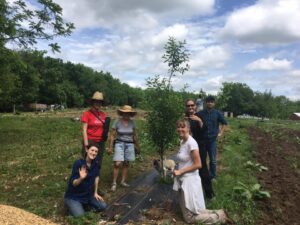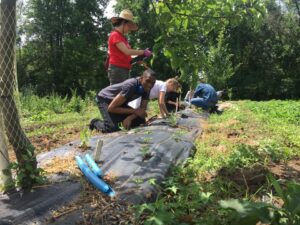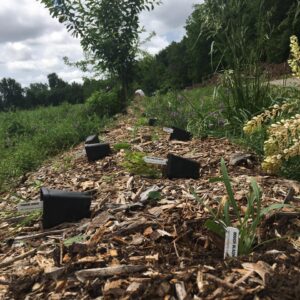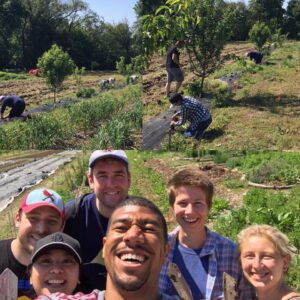Final report for FNC17-1083
Project Information
Since 2009, EarthDance has operated an organic farm school, certified organic since 2015. EarthDance offers farmer training, youth programs, volunteer opportunities and community outreach. EarthDance is located on the site of Missouri’s oldest organic farm, in Ferguson, a suburb of St. Louis, and currently grows 89 different varieties of crops on 2.3 acres of a 14-acre plot. Currently, EarthDance’s produce is enjoyed by apprentices and office staff, CSA members, shoppers at farmers markets, patrons at several local restaurants, and recipients of food donations.
In 2015, EarthDance completed a business plan with the help of consultant Chris Blanchard of Purple Pitchfork. Mr. Blanchard recommended that the farm transition to a permanent bed market-garden approach, and increase high-tunnel production. These adjustments to our methods, along with increased wholesale production, is forecasted to increase revenue to $150,000 by 2020; 2019 is the first year EarthDance is forecasted to break $100,000 in crop sales.
Since 2012, the organization has consistently worked to establish our Organic Farm School campus as a site to showcase innovative methods. Using a permaculture design lens, EarthDance strives to contribute to positive social, environmental, and economic impacts on our surrounding community and ecosystem. EarthDance utilizes cover cropping, crop rotations, and minimal tillage techniques to steward our soil. These practices minimize or prevent erosion, and allow EarthDance to rely on natural methods of fertilization and pest production to reduce using either pesticides or fossil-fuel derived fertilizer.
EarthDance practices proactive pest management, including use of row cover and insect netting, encouraging a diverse ecosystem with a habitat for beneficial insects and birds, and utilizing low-impact organic sprays such as neem oil and kaolin clay. In 2014, EarthDance established a 250-tree mixed-fruit, alley-cropped orchard with support of a SARE Farmer Rancher grant; the sustainability of the orchard is enhanced with pollinator plantings along each fruit tree berm. The berms follow swales that slow the flow of water on the property. The project "Farmscaping and Permaculture IPM at an Organic Farm School" is focused on increasing our whole-system approach to pest management, while beautifying our campus through native flower plantings.
The project achieved a greater system-wide approach to integrated pest management, and support for pollinator populations has been successful. The following are observations surrounding the results, and deeper evaluations of why each step was important for our holistic practices.
- EarthDance sought to address decreasing native pollinator habitats in the St. Louis region through native plant propagation, with our SARE project “Farmscaping and Permaculture IPM at an Organic Farm School.” Decreasing insect populations are a marker for disaster when it comes to sustainable agriculture, gardens, natural forests, and large-scale monocropping. Without increased land devoted to habitats, increased natural pollinator populations, and secure sources of pollination, agriculture will collapse. EarthDance planted a full native plant meadow, incorporated native flowering plants into permanent permaculture berms, and used insect netting to demonstrate to our cohorts of Farm & Garden Apprenticeship program participants that reliance on pesticides can be reduced or eliminated.
- The project educated apprentices and farm visitors. In this report we share numbers of farmers trained on-site, visitors to the site, and school children who came to EarthDance during the final year of the project. Due to the nature of educational projects and visual/hands-on learning, EarthDance believes that each individual exposed to these ideas and techniques is a potential avenue to decrease pesticide use, and increase natural habitats. If 5% of Farm visitors plant a few native plants in their own backyards, the collapse of insect populations in our immediate area may be avoidable (actions of other locales notwithstanding).
- EarthDance saw effective pest-management strategies increase yields due to less produce lost to pests. In addition, pollinator experts saw thriving populations of native bees and flies, as well as farmer reports of less organic-safe spray usage.
- Farmers visiting the farm from other areas commented on the insect-netting and integrated pest management strategies as ground-breaking, and informative. Despite these techniques stemming from ancient practices, traditional modern farming fails to account for the need for biodiversity. All apprentices who trained at EarthDance during this project (and all future cohorts to come) are leaving with permaculture at the center of their farming ideology. Over the course of this project, EarthDance equipped 50 farmers with permaculture and IPM expertise.
EarthDance proposed to increase the effectiveness of its pest-management efforts through floral farmscaping to attract beneficial insects, and the use of insect netting as an exclusion method.
Objective: Intersperse perennials that have proven highly attractive to beneficial insects amidst our fields, in orchard “strips” and a centrally located 3,000 square foot plot.
Progress: EarthDance has planted the orchard strips with approximately 700 native plants. The 3,000 square foot plot was solarized in the fall of 2017, and after a successful second solarization in 2018, was planted with an additional 400 plants.
Objective: Test the effectiveness of using insect netting in place of Remay rowcover as a means of excluding insects from tender crops.
Progress: EarthDance saw a decrease in pest populations, and increase in yields. While it’s difficult to denote singular causality (in terms of yield increases) with regard to EarthDance’s insect netting, it certainly has decreased damage to vegetation and fruit.
In addition to measuring the effectiveness of these methods, EarthDance is educating the beginning farmers of its Farm & Garden Apprenticeship program about the use of these techniques.
Cooperators
- (Educator and Researcher)
Research
In total, EarthDance has planted more than 1,100 plants including over 25 species of native wildflowers. EarthDance Managing Director, Rachel Levi, researched the best native plants for the farmscaping and permaculture IPM using the Michigan State University study. The chosen native plant species are proven to attract pollinators and beneficial insects. Additionally, the flowers were chosen to make the farmscape more beautiful.
EarthDance AmeriCorp VISTA member Forrest Nagy committed time to further research before planting the native plant meadow, and selected plants based on soil preference, light-level needs, drainage requirements, and what insects each plant would attract.
Some researched plants include native species such as New England Aster, Dotted Mint, and Golden Alexanders, which aid in IMP and are also aesthetically pleasing. Some beneficial insects may only prey on pests in one phase of their lives but need to survive through adulthood, to reproduce more insect allies. Plants were chosen to sustain these bug allies to ensure a thriving population of pest predators. In addition, native flowers were chosen to feed bees that pollinate crops. The plants not only had to attract desirable insects but had to be hardy enough to survive intense July heat and dryness without irrigation.
Lastly, EarthDance is trialing insect netting to be used to exclude pests in place of row cover. Row cover has insulating properties which are not always ideal for healthy vegetables and leafy greens. Insect netting on the other hand is both breathable and more durable. Thus far, EarthDance staff have been pleased by the results of this trial, and the aforementioned increased populations of pollinators due to native plantings.
EarthDance is still assessing the results of our Permaculture IPM project. 2018 was the first year in which many of the native plants sowed in 2017 blossomed, and we will see the native plant meadow in bloom for the first time in 2019. EarthDance farmers are enthusiastic about the performance of the natives for attracting pollinators, and have remarked that the air is “thick with bees.” In 2018, EarthDance partnered with the University of Missouri in St. Louis to engage a student researcher to sample insects. As native insects visited the pollinator plants, Mathew Austin collected samples at several points throughout the season to gain more data about which beneficials are responding to the plants.
The beneficial plants worked well within EarthDance’s overall integrated pest management (IPM) strategy. With their first year of native blooms, EarthDance and pollinator researchers were pleased to see significant insect activity. Unfortunately, we had no baseline numbers before this study to compare results to, but pollinators and farmers were pleased nonetheless.
The following is data collected by pollinator experts in 2018.
Insect families sighted at EarthDance included:
- Carpenter bees (Xylocopa)
- Thread-waisted wasps (Sphecidae)
- Skipper butterflies (Hesperiidae)
- Vespid wasps (Vespidae)
- Mining bees (Andrenidae)
- Swallowtail butterflies (Papilionidae)
- Pierid butterflies (Pieridae)
- Polyester bees (Colletidae)
- Leafcutter bees (Megachilidae)
- Horseflies (Tabanidae)
Our pollinator expert specialized in bee species, and surveyed numbers of these populations to determine health and overall population sustainability. (Numbers after the specimen names indicate individuals captured and observed.) The five species were:
- Common eastern bumble bee (Bombus impatiens) – 76
- Brown-belted bumble bee (Bombus griseocollis) – 75
- Two-spotted bumble bee (Bombus bimaculatus) – 56
- American bumble bee (Bombus pensylvanicus) – 23
- Black and gold bumble bee (Bombus auricomus) – 35
Over the course of the study, farmers reported less usage of the following sprays:
- Monterey Insect Spray with BT (OMRI Certified)
- Two uses during 2017, zero in 2018
- Azera (OMRI Certified)
- One use during 2017, zero in 2018
- Organicide 9/1
- One use during 2017, zero in 2018
- Dipel
- No applications recorded
Educational & Outreach Activities
Participation Summary:
Farmer/Ranchers/Other:
In 2017, EarthDance educated 24 farmers/ranchers through Farm & Garden Apprenticeship Program. Apprentices learned relevant aspects of IPM including growing with natives, propagation, permaculture berms, companion planting, and about the native planting project. Several apprentices in addition to the Apprenticeship Program during the native planting volunteer days.
In 2018, EarthDance’s Farm & Garden Apprenticeship Program trained a further 23 farmers, and educated all participants in our “Youth Exploring Agriculture and Health” (YEAH!) program about beneficial native planting. EarthDance hosted 183 adults and 831 youth through YEAH! Field trips, and each was given instruction regarding Integrated Pest Management and permaculture. We look forward to 2019, when the native plant meadow developed over the course of this project will bloom for the first time, and visitors can experience the buzzing pollinators firsthand.
Tours:
EarthDance hosted 26 free public tours on Saturdays from May 2017 through November 2017, comprised of 484 tour guests who learned about EarthDance, our permaculture berms, and the native plantings.
In 2018, EarthDance hosted 694 adult volunteers, and 380 youth, all separate from YEAH!. Volunteers planted the native plant meadow, and subsequent groups helped mulch the young seedlings. Over time, volunteers will sustain the meadow, and each group will leave EarthDance more familiar with IPM and permaculture than when they came.
Social Media Posting:
Planting Elderberries at EarthDance Facebook Video:
In this video, posted on February 15, 2018, Garden Manager Crystal Stevens showcased how to plant elderberry stem cuttings in the permaculture berms. In the Facebook post, Crystal writes,
“Rachel Levi spearheaded a pollinator project to incorporate perennial native plants into the berms to attract pollinators!”. Crystal also discussed that native perennials, which serve as pollinator attractors, have been planted in the berms.
View count: 1,800
Native Planting Volunteer Opportunity Video:
This video was posted on EarthDance’s Facebook page to notify the public of our volunteer native planting day. Volunteer Coordinator Nick Speed and Assistant Farm Manager Kaitie Adams demonstrate how to plant Canada anemone and purple prairie clover in the permaculture berms.
View count: 1,000
Volunteer Coordinator Nick Speed posted on EarthDance’s Facebook on May 16, 2017,
“Many thanks to all the volunteers who came out last Saturday to help with our Natives & Wildflowers project! For those of you who missed out, we will continue planting this Friday, from 9am-noon. To sign up, email [email protected].”
View count: 1,800
Volunteer Native Planting Day Photos and Post
Founding Director Molly Rockamann posted 22 photos of the native planting project on EarthDance’s Facebook page on May 19, 2017. Molly wrote,
“Thanks to Rachel Levi, Nickolas Speed, and all the wonderful volunteers who showed up today, the native planting was a huge success! With a USDA Sustainable Agriculture Research & Education (SARE) grant, we are able to plant 800 native plants and wildflowers into our permaculture berms in order to attract beneficial insects and pollinators!”
View count: 857
Garden Manager Crystal Stevens posted,
“Thank you North Central Region SARE for promoting Ecological Farmscaping EarthDance Organic Farm School” with a link to NCR SARE Facebook page and Rachel Levi’s article, “How Can Native Flowers Save Your Veggies?”
View count: 5,325
Founding Director, Molly Rockmann posted on EarthDance’s Facebook page on June 22, 2017:
“In honor of National Pollinator Week, check out “How Native Flowers Can Save Your Veggies”: http://earthdancefarms.org/2017/06/earthdance-goes-native/”
View count: 385
How Can Native Flowers Save Your Veggies?– Rachel Levi
This article was published on August 8, 2017. Rachel mentions a common question asked by EarthDance guests, “How does an organic farm deal with pests?” Within this article, Rachel discusses how organic practices, integrated pest management, and permaculture techniques help organic farms flourish.
“NCR-SARE (North Central Region Sustainable Agriculture Research and Education, a division of the US Department of Agriculture) grant that enables us to plant a huge number of native plants in order to make the farm a more diverse, better-functioning ecosystem. EarthDance is grateful to NRC-SARE for their support of this project! As they mature, superstar native species like New England Aster, Dotted Mint, and Golden Alexanders will attract beneficial insects and pollinators while beautifying our farmscape. A total of 800 native plants will be interplanted with EarthDance’s permaculture orchard trees.”
Rachel outlines how the natives will feed pollinators and other beneficial insects in a technique called farmscaping, which, “In our SARE grant, EarthDance proposed to farmscape by planting native plants in our fruit tree berms.” Linked in the article is the Michigan State University study: Attracting Beneficial Insects with Native Flowering Plants. This article also outlines the numerous benefits of the project including feeding bees that pollinate crops, farm beautification, medicinal uses of the natives like boneset and echinacea, and continuing to educate the public by demonstrating the project.
A Field Walk to Visit Native Plants– Rachel Levi
In this article published on March 14, 2018, Rachel highlights several natives including dotted mint, red milkweed, lance leaf coreopsis, hyssop, and boneset. “EarthDance’s Native’s Project kicked off this spring. EarthDance is planting hundreds of natives across our farm school campus. The species were chosen particularly for their attractiveness to pollinators and beneficial insects. Since May, we’ve planted twenty+ species of native wildflowers and over 700 plants!”
Volunteer projects:
Volunteer Coordinator Nick Speed posted on EarthDance’s Facebook to call upon volunteers to help with the native planting project on May 4, 2017:
“Join EarthDance Organic Farm School as we plant hundreds of native plants! Superstar native species like New England Aster, Dotted Mint, and Golden Alexanders will attract beneficial insects and pollinators while beautifying our farmscape. A total of 800 native plants will be interplanted with EarthDance’s permaculture orchard trees. Learn more about the project and help us plant on Friday, May 19th, 9am-12pm. Please bring your own scissors (if you have some) to help snip holes in the landscape fabric where they will be planted.”
On May 12, 2017, three EarthDance staff members participated in a native planting training to prepare for the upcoming volunteer native planting days. May 13, 2017 was the first Native Plants and Wildflowers Volunteer Planting Day led by Volunteer Coordinator Nick Speed. Another volunteer planting day was led by Nick on May 19, 2017. Altogether, 35 volunteers planted roughly 700 natives.
On September 19th 2018, EarthDance hosted an IPM field day. Thirteen individuals attended the field day, including extension agents, professional farmers, backyard gardeners, and conservation officers. Assistant Farm Manager Kaitie Adams covered tiered approaches within IPM, explaining the necessity of vigilance on a farm. Before pests can be managed, they must be identified. Once identified, farmers are required to select a management practice that suits the site. For EarthDance, this means permaculture oriented non-chemical solutions like: trap crops, alley cropping, native and companion planting, use of insect netting and row-covers.
After the educational segment of the field day, volunteers helped transplant starts to form EarthDance’s native plant meadow. Led by former garden manager and herbalist Crystal Stevens, volunteers planted the following species:
- Nodding Wild Onion
- Butterfly Milkweed
- Rose Verbena
- Slender Mountain Mint
- Ohio Horsemint
- Calamint
- Grey Headed Coneflower
- Yellow Coneflower
- Purple Prairie Clover
- Purple Coneflower
- Agave Palse Aloe
- Rough Blazing Star
- Golden Alexander
- Oxeye Sunflower
- New England Aster
- Blue Sage
- New Jersey Tea
- Smooth Aromatic Aster
- Goldenrod
- Beauty Berry
- Swamp Milkweed
- Marsh Milkweed
- Foxglove
- Spicebush
- Elderberry
- Lead Plant
- Button Bush
- Ironweed
- Black Eyed Susan
- Rattlesnake Master
- Monarda
- Little Bluestem
These native species attract a plethora of fly species, many of which have been seen at EarthDance. The increased native vegetation will reliably attract these populations, developing natural pest management through habitat creation. As habitats mature, natural predators will begin to frequent the EarthDance acreage with greater regularity, hopefully returning year after year to diminish the effects of pest scourges. Over time, it is possible that certain species of pest will find their populations so depleted that EarthDance can almost eradicate all uses of sprays.
EarthDance’s IPM field day also included post-instruction surveys to gauge success:
- 100% of respondents indicated that the field day was “excellent,” or “good.”
- 100% of respondents responded that their understanding of integrated pest management had increased “significantly.”
- 100% replied that they would immediately implement one or more of the new methods they had learned about at the field day.
Plans to further communicate results:
EarthDance will track insect populations comparative to previous years, publishing results annually in our newsletters. After this final report, most tracking will remain within the farm-team’s year to year documentation--although many of those records will be made public through the aforementioned newsletters. Since EarthDance cannot indefinitely rely on local universities tracking our insect populations, the effects of these plantings and native propagation will be evaluated through yields, rather than capturing individual members of insect species.
In 2018 we will continue to educate public tour guests on free Saturday tours as well as see recurring volunteers helping Garden Manager Crystal Stevens in the permaculture berms with natives. There will be posts on EarthDance's social media and published articles regarding these recurring volunteers. This year EarthDance will welcome 28 farmer-rancher apprentices who will assist in the berms on their field shifts and also 6 Junior Farm Crew members who will be integrated with apprentices during these field shifts.




Learning Outcomes
EarthDance gained an incredible amount of knowledge as a direct result of this project. Office staff, farm staff, and grant writing staff came together to pursue a better understanding of integrated pest management (IPM).
They learned:
- To develop an effective permaculture system, each level of the ecosystem must be taken into account: water management, soil biodiversity, insects and native pollinators, and native plant selection.
- To research dynamic accumulators like Comfrey and Dandelions, in order to create more effective guilds and permaculture designs.
- To attract native pollinators in order to deter or eliminate pests.
- To plant native plants, which are hardier than many non-native varieties and more effectively attract native pollinators.
The advantages of implementing a native pollinator garden are numerous in the long term: decreased reliance on pesticides, greater yields due to more reliable pollination, and new habitat for threatened insect populations. Although critics of IPM reference monoculture practices, wherein planting large swathes of land with native flowers can be cost inefficient, IPM is a plan for the future’s soil health and continued existence of pollinators, rather than an obsession with immediate profit.
The long term advantages of integrated pest management practices lay within the water table and the soil. With fewer pesticides, less fertilization needs, and the greater erosion protection provided by native plants, less farm detritus is washed away during spring and autumn storms. Soil continues to sit upon the fields, and the little that does travel downstream has negligible effects upon the environment.
This project evaluated IPM, and whether it is an effective alternative to traditional pesticide use for EarthDance. Although it has been widely documented that labor-intensive farming techniques cost significantly more in the short term, long term benefits can outweigh these startup costs. EarthDance will continue to reap the rewards of this project for generations, and the farmers are delighted with the successes we have observed: elevated pollinator numbers, greater yields, and reduced spray usage all indicate that IPM is both a short, and a long term benefit.
Due to unavailability of long-term data from EarthDance surrounding the IPM project, we will refer to numerous studies conducted by the University of California’s Statewide Integrated Pest Management Program, the results documented by the federal government’s Environmental Protection Agency, and the documentation offered by the National Pesticide Information Center, in order to show that this project will meet our long-term expectations, and provide a benefit to the agricultural community at-large in the St. Louis area.
Contrasting viewpoints on IPM take into account the fluid characteristics of any natural system, raising questions surrounding the idea that IPM successfully decreases effort over time. One study notes that: “One goal of a mature IPM system is to establish equilibrium within the ecosystem, such that frequent chemical intervention is not required. This goal is rarely achieved, however, due to the dynamic nature of pests, horticultural practices, crop values, new pest control technologies, new regulations and the range of possible ecological landscape interactions.”
While EarthDance is aware of the limitations of IPM, and its subjectivity with regard to the environment’s fluctuations, we are confident that taking these steps will serve to provide EarthDance with a reliable starting point to decrease pest populations.
Project Outcomes
A native plant specialist from the St. Louis area commented on our integrated pest management project’s success upon her visit, saying that “this project should provide the perfect oasis for insects in Ferguson. Since you’re surrounded by developed concrete on nearly all sides, this meadow will offer declining native pollinators a haven.”
Impressed by our commitment to creating habitat, pollinator researcher Matthew Austin commented that there were several species of native pollinators present at EarthDance he’d only observed in state and national parks.